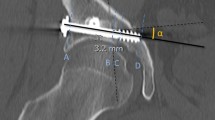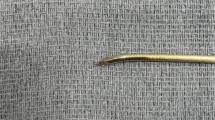Abstract
Introduction
The treatment of displaced acetabular fractures with formal open reduction and internal fixation has gained general acceptance. However, extensile exposure can lead to complications. Two-dimensional fluoroscopy-based computerized navigation for placement of percutaneous screw across non-displaced acetabular fractures has attracted interest by making use of stored patient-specific imaging data to provide real-time guidance in multiple image planes during implant placement. The purpose of the present study was to document early treatment results and complications associated with this new technique and evaluate its clinical application to displaced acetabular fractures amenable to closed or limited open reduction.
Materials and methods
Eighteen adult patients with 12 non-displaced and 8 displaced acetabular fractures were treated with percutaneous screw fixation under the guidance of a fluoroscopy-based navigation system. There were 14 men and four women with a mean age of 42.1 years (range 19–54 years). According to the AO and Orthopaedic Trauma Association Classification, there were nine 62-A3, five 62-B1, three 62-B2, and three 62-B3. The mean follow-up was 21 months (range 12–28 months). The mean time from injury to surgery was 4 days (range 2–7 days).
Results
A total of 30 acetabular screws were inserted, including 21 anterior column screws and 9 posterior column screws. The average operation time was 24.6 min (range 16–47 min) from the image acquisition to wound closure. The average fluoroscopic time was 28.4 s (range 11–58 s). Compared to the final position of the screw, the average deviated distance of wire tip was 2.5 mm (range 1.1–3.6 mm) and the average trajectory difference was 2.45° (range 1.5°–4.6°). Maximal gap displacement averaged 10 mm (range 2–22 mm) preoperatively and 3 mm (range 0–5 mm) postoperatively; while maximal step displacement averaged 4 mm (range 1–10 mm) preoperatively and 2 mm (range 0–4 mm) postoperatively. One patient sustained a transient femoral nerve palsy and resolved 2 months after the operation. No superficial or deep infection occurred. Using the rating system of D’Aubigne and Postel, 13 patients had excellent results, 4 patients had good results, and 1 patient had a fair result.
Conclusion
Percutaneous screw fixation of acetabular fractures with 2D fluoroscopy-based navigation could be applied not only to non-displaced fractures but also to displaced fractures amenable to closed or limited open reduction.


Similar content being viewed by others
References
Alonso JA, Shaw DL, Maxwell A, McGill GP, Hart GC (2001) Scattered radiation during fixation hip fractures: is distance alone enough protection? J Bone Joint Surg (Br) 83:815–818
Attias N, Lindsey RW, Starr AJ, Borer D, Bridges K, Hipp JA (2005) The use of a virtual three-dimensional model to evaluate the intraosseous space available for percutaneous screw fixation of acetabular fractures. J Bone Joint Surg (Br) 87:1520–1523
Borrelli J, Goldfarb C, Catalano L, Evanoff BA (2002) Assessment of articular fragment displacement in acetabular fractures: a comparison of computerized tomography and plain radiographs. J Orthop Surg 16:449–456
Carmack DB, Moed BR, McCarroll K, Freccero D (2001) Accuracy of detecting screw penetration of the acetabulum with intraoperative fluoroscopy and computed tomography. J Bone Joint Surg (Am) 83:1370–1375
Chmelova J, Sir M, Jecminek V (2005) CT-guided percutaneous fixation of pelvic fractures. Case reports. Biomed Papers 149:177–181
Crowl AC, Kathler DM (2002) Closed reduction and percutaneous fixation of anterior column acetabular fractures. Comput Aided Surg 7:169–178
D’Aubigne M, Postel M (1954) Functional results of hip arthroplasty with acrylic prosthesis. J Bone Joint Surg (Am) 36:451–475
Gay SB, Sistrom C, Wang GJ, Kahler DA, Boman T, McHugh N, Goitz HT (1992) Percutaneous screw fixation of acetabular fractures with CT guidance: preliminary results of a new technique. AJR 158:819–822
Geerling J, Gosling T, Gosling A, Ortega G, Kendoff D, Citak M, Krettek C (2008) Navigated pedicle screw placement: experimental comparison between CT- and 3D fluoroscopy-based technique. Comput Aided Surg 13:157–166
Giannoudis PV, Tzioupis CC, Pape HC, Roberts CS (2007) Percutaneous fixation of the pelvic ring. J Bone Joint Surg (Br) 89:145–154
Gross T, Jacob AL, Messmer P, Regazzoni P, Steinbrich W, Huegli RW (2004) Transverse acetabular fracture: hybrid minimal access and percutaneous CT-navigated fixation. Am J Roentgenol 183:1000–1002
Hinsche AF, Giannoudis PV, Smiths RM (2002) Fluoroscopy-based multiplanar image guidance for insertion of sacroiliac screws. Clin Orthop Relat Res 395:135–144
Huegli RW, Staedele H, Messmer P, Regazzoni P, Steinbrich W, Gross T (2004) Displaced anterior column acetabular fracture: closed reduction and percutaneous CT-navigated fixation. Acta Radiol 45:618–621
Hufner T, Gebhard F, Grutzner PA, Messmer P, Stockle U, Krettek C (2004) Which navigation when? Injury 35(Suppl A):SA30–SA34
Kaempfe FA, Bone LB, Border JR (1991) Open reduction and internal fixation of acetabular fractures: heterotopic ossification and other complications of treatment. J Orthop Trauma 5:439–445
Kahler DM (2004) Image guidance. Clin Orthop Relat Res 421:70–76
Kendoff D, Gardner MJ, Citak M, Kfuri M, Thumes B, Krettek C, Hufner T (2008) Value of 3D fluoroscopic imaging of acetabular fractures comparison to 2D fluoroscopy and CT imaging. Arch Orthop Trauma Surg 128:599–605
Langlotz F (2004) Potential pitfalls of computer aided orthopedic surgery. Injury 35(Suppl 1):17–23
Letournel E (1980) Acetabulum fractures: classification and management. Clin Orthop Relat Res 151:81–106
Lin YC, Chen CH, Huang HT, Chen JC, Huang PJ, Hung SH, Liu PC, Lee TY, Chen LH, Cheng JK (2008) Percutaneous antegrade screwing for anterior column fracture of acetabulum with fluoroscopic-based computerized navigation. Arch Orthop Trauma Surg 128:223–226
Matta JM (1994) Operative treatment of the acetabular fractures through the ilioinguinal approach—a ten year perspective. Clin Orthop Relat Res 305:10–19
Matta JM, Merritt PO (1988) Displaced acetabular fractures. Clin Orthop Relat Res 230:83–97
Mehlman CT, DiPasquale TG (1997) Radiation exposure to orthopaedic surgical team during fluoroscopy: how far away is far enough. J Orthop Trauma 11:392–398
Mosheiff R, Khoury A, Weil Y, Liebergall M (2004) First generation computerized fluoroscopic navigation in percutaneous pelvic surgery. J Orthop Trauma 18:106–111
Mouhsine E, Garofalo R, Borens O, Wettstein M, Blanc CH, Fischer JF, Moretti B, Leyvraz PF (2005) Percutaneous retrograde screwing for stabilisation of acetabular fractures. Injury 36:1330–1336
Muller ME (1996) The comprehensive classification of fractures of long bones, spine and pelvis, 2nd edn. Springer, Berlin
Myao KA (1994) Open reduction and internal fixation of the acetabulum. Clin Orthop Relat Res 305:31–37
Nolte LP, Beutler T (2004) Basic principles of CAOS. Injury 35(Suppl A):SA6–SA16
Norris BL, Hahn DH, Bosse MJ, Kellam JF, Sims SH (1999) Intraoperative fluoroscopy to evaluate fracture reduction hardware placement during acetabular surgery. J Orthop Trauma 13:414–417
Pantazoupoulos T, Mousafiria C (1989) Surgical treatment of central acetabular fractures. Clin Orthop Relat Res 246:57–64
Pennal GF, Davidson J, Garside H, Plewes J (1980) Results of treatment of acetabular fractures. Clin Orthop Relat Res 151:115–123
Przkora R, Bosch U, Zelle B, Panzica M, Garapati R, Krettek C, Pape HC (2002) Damage control orthopedics: a case report. J Trauma 53:765–769
Roberts CS, Pape HC, Jones AL, Malkani AL, Rodriguez JL, Giannoudis PV (2005) Damage control orthopaedics. J Bone Joint Surg Am 87:434–449
Rommens PM (2007) Is there a role for percutaneous pelvic and acetabular reconstruction? Injury 38:463–477
Sanders R, Koval KJ, DiPaquale T, Schmelling G, Stenzlert S, Ross E (1993) Exposure of the orthopaedic surgeon to radiation. J Bone Joint Surg Am 75:326–330
Starr AJ, Jones AL, Reinert CM, Borer DS (2001) Preliminary results and complications following limited open reduction and percutaneous screw fixation of displaced fractures of the acetabulum. Injury 32(Suppl 1):45–50
Starr AJ, Reinert CM, Jones AL (1998) Percutaneous fixation of the columns of the acetabulum: a new technique. J Orthop Trauma 12:51–58
Stöckle U, Krettek C, Pohlemann T, Messmer P (2004) Clinical applications—pelvis. Injury 35(Suppl 1):46–56
Wieners G, Pech M, Beck A, Konig B, Erdmenger U, Stockle U, Wust P, Felix R, Schroder RJ (2005) Comparison of radiation dose and image quality of Siremobil-IsoC(3D) with a 16-slice spiral CT for diagnosis and intervention in the human pelvic bone. Rofo 177:258–264
Wright R, Barrett K, Christie MJ, Johnson KD (1994) Acetabular fractures: long-term follow-up of open reduction and internal fixation. J Orthop Trauma 8:397–403
Acknowledgments
Each author certifies that his or her institution has approved or waived approval for the human protocol for this investigation and that all investigations were conducted in conformity with ethical principles of research.
Conflict of interest statement
Each author certifies that he or she has no commercial associations (e.g., consultancies, stock ownership, equity interest, patent/licensing arrangements, etc.) that might pose a conflict of interest in connection with the submitted article.
Author information
Authors and Affiliations
Corresponding author
Rights and permissions
About this article
Cite this article
Hong, G., Cong-Feng, L., Cheng-Fang, H. et al. Percutaneous screw fixation of acetabular fractures with 2D fluoroscopy-based computerized navigation. Arch Orthop Trauma Surg 130, 1177–1183 (2010). https://doi.org/10.1007/s00402-010-1095-2
Received:
Published:
Issue Date:
DOI: https://doi.org/10.1007/s00402-010-1095-2




